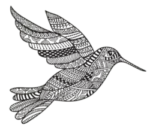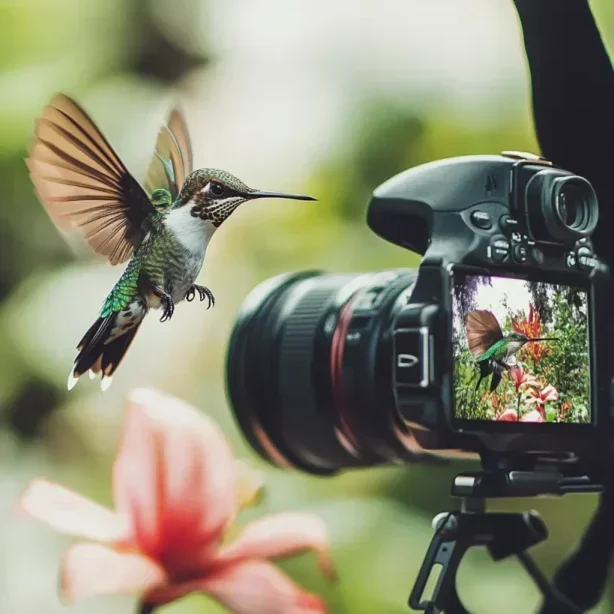(Or: How to Freeze Time with a Camera)
Photographing hummingbirds presents one of the most exciting yet challenging pursuits in wildlife photography. Capturing these living jewels requires a unique combination of technical skill, patience, and understanding of hummingbird behavior. Let’s explore how to transform those fleeting moments of aerial artistry into lasting images.
Before diving into technical details, it’s important to grasp what we’re trying to achieve. Hummingbirds beat their wings up to 80 times per second during normal flight. To freeze this motion, we need shutter speeds faster than the human eye can perceive. We’re essentially attempting to capture moments that exist between heartbeats.
The basic challenges include:
- Ultra-fast wing movements
- Unpredictable flight patterns
- Tiny size requiring precise focus
- Complex lighting requirements
Essential Equipment
While it’s possible to photograph hummingbirds with basic equipment, certain tools significantly increase your chances of success. Think of your camera gear as a time-stopping toolkit, each piece serving a specific purpose in capturing these speed demons.
The fundamental kit should include:
- Camera with high-speed shooting capabilities
- Macro lens or telephoto lens (200mm minimum)
- Multiple flash units for high-speed sync
- Sturdy tripod
- Remote trigger system
The Setup Strategy
Success begins with proper setup. Creating an effective hummingbird photo studio requires careful consideration of multiple factors. Your goal is to create an environment where these tiny subjects feel comfortable while remaining within your camera’s optimal shooting range.
Position your main elements:
- Primary perch or feeding station
- Clean, natural-looking background
- Flash units at complementary angles
- Camera at optimal distance for your lens
Mastering The Light
Lighting represents perhaps the most crucial element in hummingbird photography. You have two main approaches: natural light or high-speed flash. Each has its advantages and creates different effects.
For natural light photography:
- Use early morning or late afternoon light
- Position yourself with the sun at your back
- Watch for iridescent feather effects
- Consider using reflectors for fill light
For flash photography:
- Set up multiple flash units
- Use flash diffusers to soften light
- Position flashes to highlight feather detail
- Consider using flash triggers for precise timing
Camera Settings Decoded
Your camera settings create the foundation for successful shots. While specific settings vary based on conditions and equipment, certain principles remain constant.
Basic settings start with:
- Shutter speed: 1/2000 sec or faster for wing freeze
- Aperture: f/8 to f/11 for adequate depth of field
- ISO: As low as possible while maintaining speed
- Focus mode: Continuous autofocus with tracking
Behavior and Timing
Understanding hummingbird behavior dramatically improves your chances of getting great shots. These tiny birds often follow predictable patterns, especially around feeders or favorite flowers.
Watch for:
- Regular feeding schedules
- Preferred perching spots
- Territorial defense patterns
- Courtship displays
Advanced Techniques
Once you’ve mastered the basics, several advanced techniques can help create even more spectacular images.
Consider exploring:
- Multiple flash setups for 3D lighting
- High-speed trigger systems
- Focus stacking for maximum detail
- Background manipulation techniques
Post-Processing Perfection
The final step in creating stunning hummingbird images occurs in post-processing. While it’s crucial to get things right in camera, thoughtful editing can enhance your images significantly.
Key post-processing considerations:
- Careful sharpening for feather detail
- Color balance to capture true iridescence
- Selective noise reduction
- Background enhancement or softening
Ethical Considerations
As with all wildlife photography, the well-being of your subjects must come first. Never stress birds by getting too close or using excessive flash, and always maintain appropriate distance.
Responsible practices include:
- Limiting flash frequency
- Providing escape routes
- Respecting breeding season
- Maintaining clean feeders
Conclusion: Patience Rewards
Successfully photographing hummingbirds requires a perfect blend of technical skill, naturalist knowledge, and patience. Each successful image represents countless hours of preparation, practice, and persistence.
Remember: When you finally capture that perfect shot of a hovering hummingbird, you’ve done more than take a photograph – you’ve frozen a moment of natural magic that most human eyes never see.


